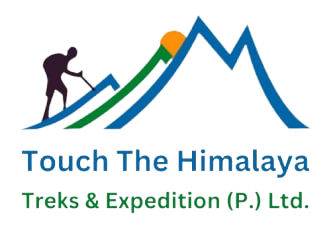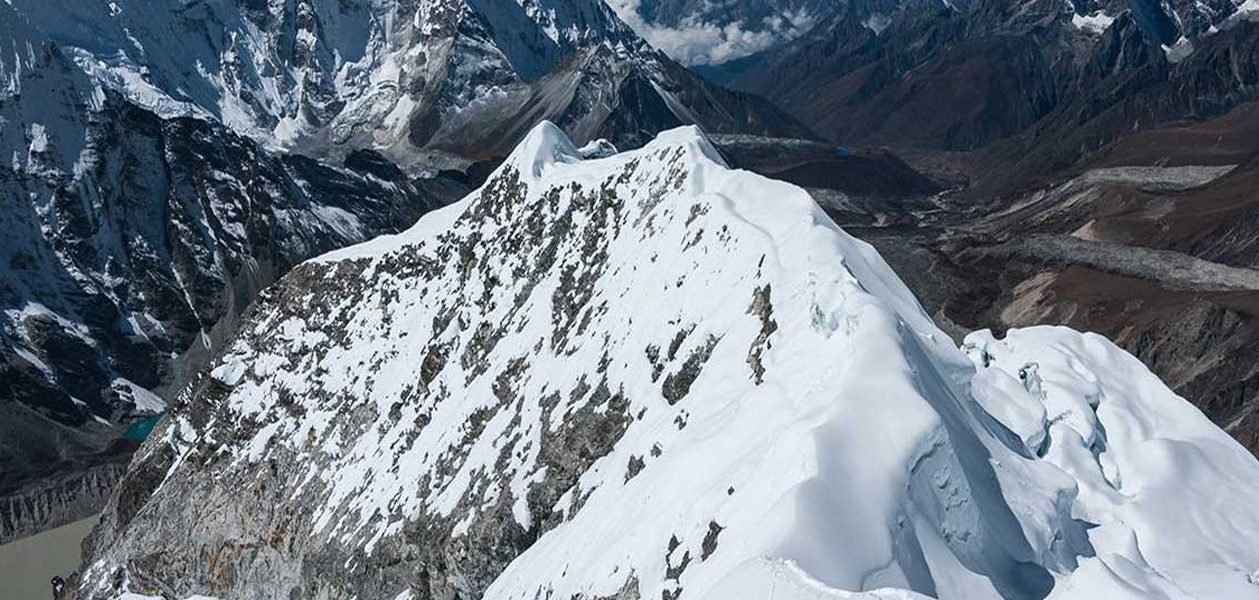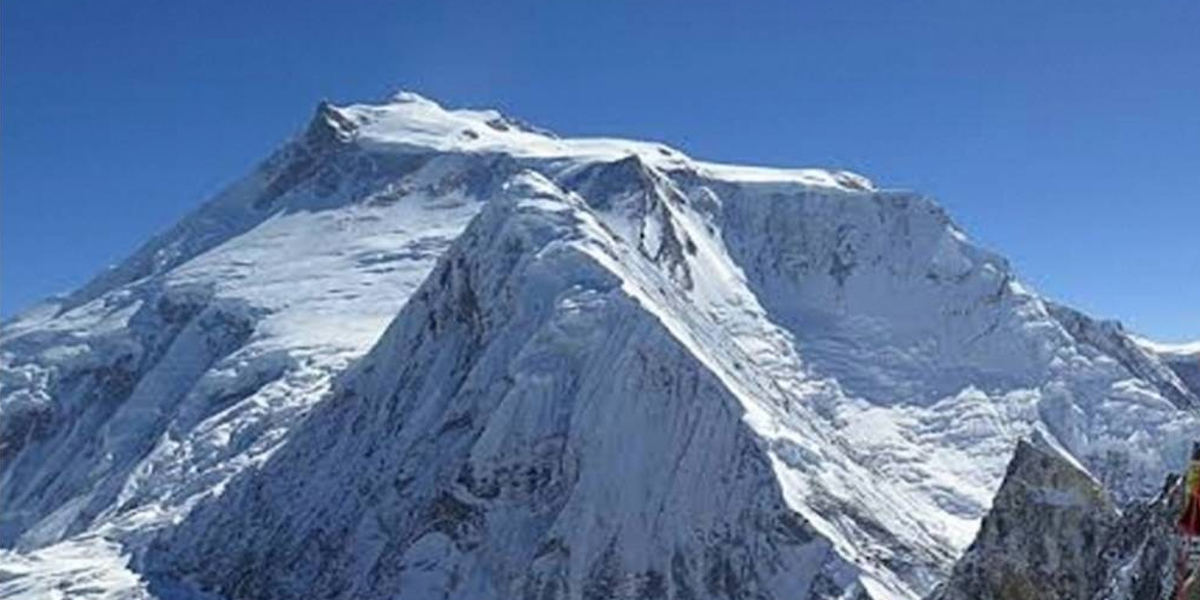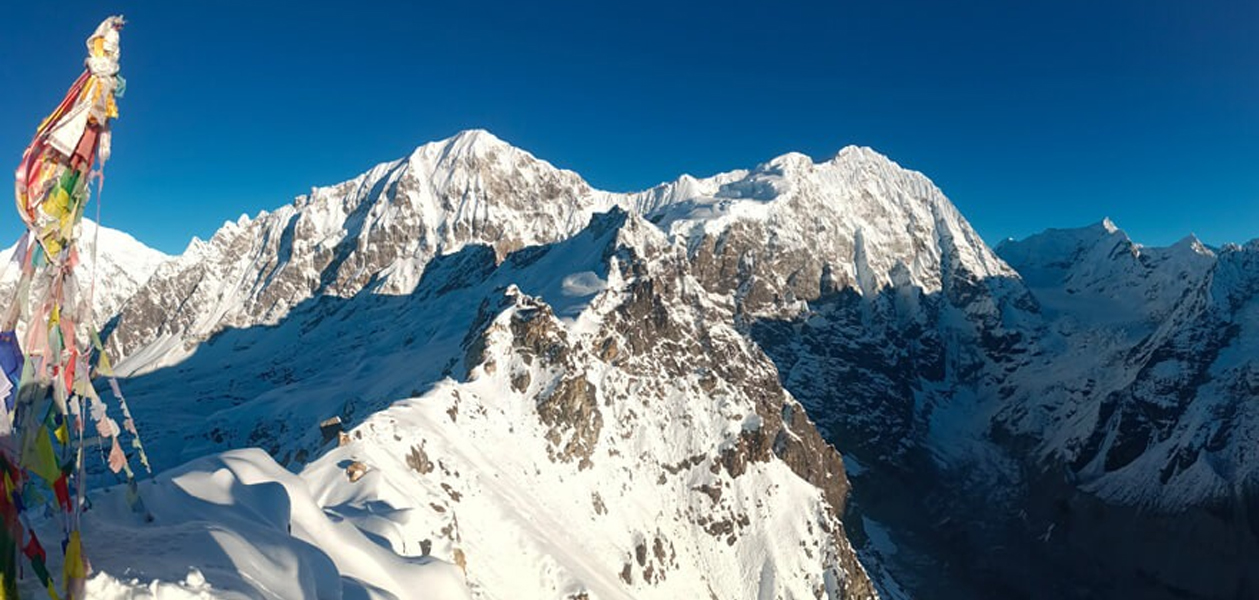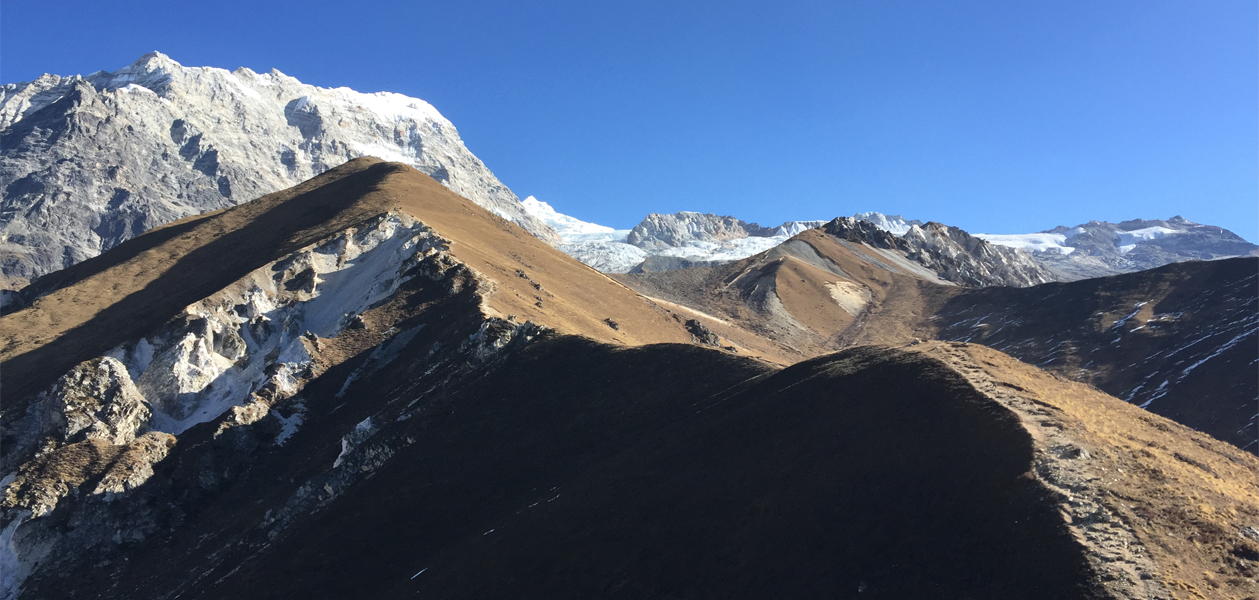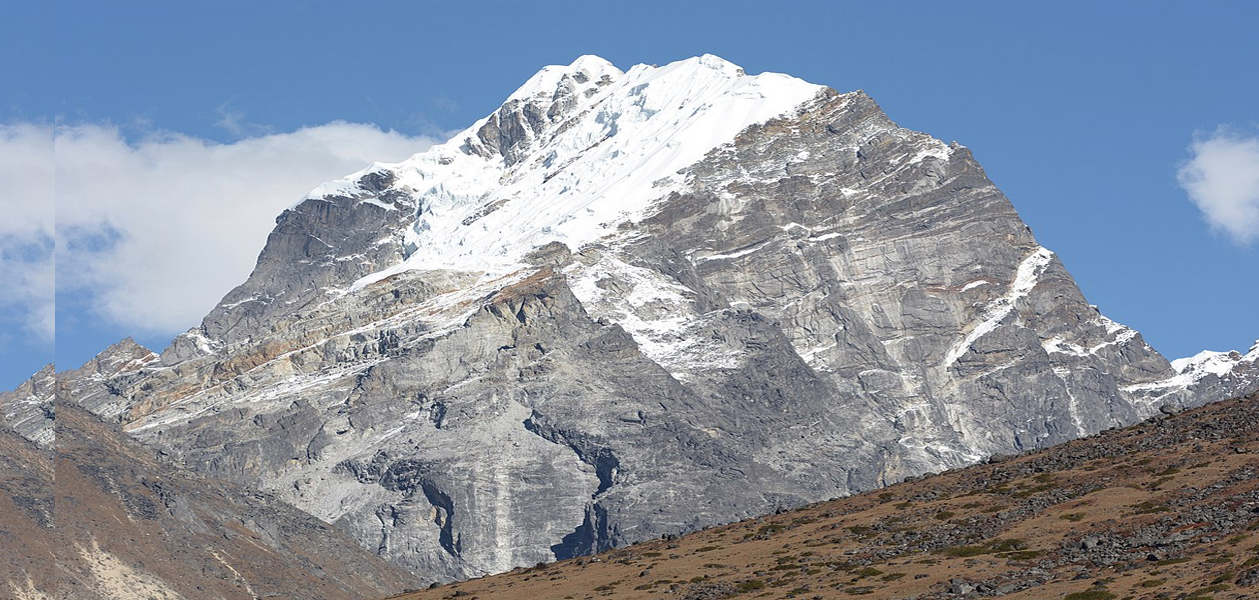Island Peak Climbing - 19 Days
Demanding Activities-
Duration
19 Days
-
Activity
Climbing / Expedition
-
DifficultyChallenging Trek
These treks are the most challenging and require a high level of physical fitness and mountaineering skills. The altitude may go up to 6,000 meters or more, and the terrain can be extremely rugged and steep, with challenging passes and technical sections. These treks often involve mountaineering and require special equipment and permits. Examples of difficult treks in Nepal are the Everest Three Passes Trek, Makalu Base Camp Trek, and the Kanchenjunga Base Camp Trek.
-
Max. Altitude
6189 m
-
Starts
Kathmandu
-
Ends
Kathmandu
-
Group Size
Minimum: 2 pax
-
Best Season
March-May/Sept-Dec
PRICE PER PERSON
- 1 PAX US$2366
- 2 PAX US$2027
- 3 PAX US$2008
- 4 PAX US$1957
- 5-10 PAX US$1933
- 11-20 PAX US$1882
- Highlights
- Itinerary
- Route Map
- What Included / Excluded
- Dates & Availability
- Additional Information
TRIP HIGHLIGHTS
- Breathtaking panoramic views of some of the world’s highest peaks, including Mount Everest, Lhotse, Nuptse, Makalu, and Ama Dablam.
- Takes you through picturesque Sherpa villages, rhododendron forests, and majestic valleys, providing an immersive cultural and natural experience.
- Island Peak Summit, at an altitude of 6,189 meters, rewards with breathtaking views of the surrounding peaks and glaciers, making all the effort and hard work worthwhile.
- Explore remote and untouched landscapes, glaciers, and crevasses, adding to the thrill and excitement of the climb.
- Interact with the Sherpa community, visit ancient monasteries, and learn about their traditions and way of life.
- Everest Base Camp, which is an iconic destination, experiencing the buzzing atmosphere of climbers and mountaineering expeditions.
- Witness the sunrise painting the surrounding peaks in golden hues, creating a breathtaking spectacle.
- Explore the unusual flora and animals of the Sagarmatha National Park.
Island Peak Climbing Overview
Island Peak Climbing, also known as Imja Tse, is a popular mountaineering adventure in the Everest region of Nepal. It offers climbers the opportunity to experience the thrill of climbing a challenging peak while being surrounded by the majestic Himalayan mountains. Climbing Island Peak is a demanding activity due to the difficulty of the climb as well as accessibility concerns. The east flank and south-west ridge are the typical routes for Island Peak Climbing.
Island Peak is located in the Everest region of Nepal, within the Sagarmatha National Park. It stands at an elevation of 6,189 meters (20,305 feet), making it one of the prominent trekking peaks in the area.
Lukla is the starting point of most Everest region treks, including Island Peak climbing. You’ll fly from Kathmandu to Lukla, which is situated at an elevation of approximately 2,860 meters (9,383 feet). It serves as the gateway to the Khumbu Valley and is known for its unique mountain airstrip. After landing in Lukla, you’ll begin your trek towards Phakding. The trail descends through beautiful forests and crosses suspension bridges over the Dudh Koshi River. Phakding, located at around 2,610 meters (8,563 feet), offers a serene and picturesque setting.
From Phakding, you’ll continue trekking along the banks of the Dudh Koshi River, gradually ascending to Namche Bazaar. This vibrant Sherpa town is a major trading hub and serves as the commercial and administrative center of the Everest region. Namche Bazaar sits at an elevation of approximately 3,440 meters (11,286 feet) and provides stunning views of Everest and surrounding peaks.
Leaving Namche Bazaar, the trail takes you through rhododendron forests and traverses the Dudh Koshi River before ascending to Tengboche. Tengboche is home to one of the most important Buddhist monasteries in the region, Tengboche Monastery. Situated at an altitude of around 3,867 meters (12,687 feet), this monastery offers panoramic views of Everest, Ama Dablam, and other neighboring peaks.
Continuing your ascent, you’ll trek through Pangboche, a traditional Sherpa village, before reaching Dingboche. Dingboche is located at around 4,410 meters (14,468 feet) and provides a picturesque setting amidst terraced fields and stone-walled houses. It is a popular acclimatization stop before heading towards Island Peak.
From Dingboche, you’ll trek to Chhukung, a small settlement situated at around 4,730 meters (15,518 feet). Chhukung serves as a base for climbing peaks in the area, including Island Peak. Here, you’ll have the opportunity to acclimatize further, undergo training for technical climbing skills, and make necessary preparations for the ascent.
Leaving Chhukung, you’ll embark on a trail that leads to Island Peak Base Camp. The trek takes you through beautiful alpine landscapes, glacial moraines, and offers views of Lhotse, Nuptse, and other magnificent peaks. Island Peak Base Camp is usually set at an elevation of around 5,200 meters (17,060 feet) and serves as a temporary home for climbers during the expedition.
The final phase of the climb involves reaching the summit of Island Peak itself. From Base Camp, you’ll make your way to High Camp at around 5,600 meters (18,372 feet) and then embark on the summit push. The climb to the summit typically takes several hours and requires technical skills and determination. Reaching the summit, standing at 6,189 meters (20,305 feet), is a remarkable achievement and provides unforgettable views of the surrounding Himalayan peaks.
Cultural Experience:
While Island Peak Climbing primarily focuses on the mountaineering aspect, it also offers a rich cultural experience. The trekking trail to Island Peak Base Camp passes through several Sherpa villages, providing an opportunity to immerse yourself in the local culture and traditions. You’ll have a chance to interact with the Sherpa people, known for their mountaineering prowess and warm hospitality. Visiting monasteries, observing Buddhist rituals, and participating in cultural ceremonies can be part of the cultural experience during the trek.
Biodiversity:
The Everest region is known for its incredible biodiversity. As you trek towards Island Peak, you’ll traverse through diverse landscapes, including lush forests of rhododendron, pine, and juniper. The region is home to various wildlife species such as musk deer, Himalayan Thar, and a variety of bird species. Although the focus of Island Peak climbing is on the mountain, you may encounter glimpses of the region’s natural beauty and wildlife along the trekking trail.
Climate:
The climate in the Everest region can vary depending on the season. Spring (March to May) and autumn (September to November) are considered the best seasons for climbing Island Peak. During these months, the weather is generally stable, with clear skies and mild temperatures. The daytime temperatures can range from 5°C to 15°C (41°F to 59°F), but it can get colder at higher altitudes and during the night.
Difficulty Level:
Island Peak is classified as a “trekking peak,” which means it is suitable for climbers with basic mountaineering skills and experience. However, it still requires physical fitness, endurance, and some technical climbing proficiency. The climb involves steep sections, snow slopes, and some technical sections near the summit. It is recommended for climbers to have prior experience with using crampons, ice axes, and ropes.
Equipments:
Some of the key equipment required for Island Peak climbing includes mountaineering boots, crampons, ice axes, climbing harness, helmet, ropes, carabiners, quickdraws, ascenders, descenders, Prusik cords, trekking poles, warm clothing (layers, down jacket, thermal base layers), a sleeping bag suitable for cold temperatures, sunglasses, sunscreen, headlamp, gloves, gaiters, and a backpack. These items are crucial for various aspects of the climb, such as navigating icy terrain, ascending steep sections, protecting against extreme weather conditions, and ensuring personal safety.
Accommodation:
During the trek to Island Peak Base Camp, you’ll find a range of accommodation options along the trail. The most common types of accommodation are teahouses or lodges, which provide basic amenities such as beds, blankets, and communal dining areas. These teahouses offer a cozy atmosphere, a chance to connect with other trekkers, and enjoy local Sherpa hospitality. While the facilities may be simple, they offer a comfortable resting place after a day of trekking.
Meals:
Touch the himalays understand the importance of nutritious and delicious meals during your trek. Our package includes full-board meals, which consist of breakfast, lunch, and dinner. We ensure that the meals are hygienically prepared, offering a variety of local and international cuisines. We cater to dietary restrictions and preferences to the best of our abilities, ensuring you have an enjoyable dining experience throughout the trek.
Insurance:
We highly recommend travel insurance for the Island Peak Climbing, and we can assist you in acquiring suitable coverage. We work with reputable insurance providers to help you obtain comprehensive insurance that includes high-altitude trekking and helicopter evacuation in case of emergencies. We want to ensure that you are adequately protected throughout your trekking journey.
Safety During Island Peak Climbing:
Getting to the summit from the base camp Island Peak climbing can be a one day activity for some people. Many Island Peak climbing enthusiasts however, would rather enjoy mountaineering type climbing at high camp as this provides great pleasure to Island Peak Climbing and help them climb safely. If you are physically fit and properly acclimatized, you can participate in Island Peak Climbing Trail. Island Peak Climbing can be done in the months between March and May and also September to December.
Permits:
Sagarmatha National Park Entry Permit: The Sagarmatha National Park, a UNESCO World Heritage site, protects the Everest region’s natural and cultural treasures. Every visitor to the region needs to obtain a Sagarmatha National Park Entry Permit.
TIMS (Trekkers’ Information Management System) Card: The TIMS Card is mandatory for all trekkers in Nepal. It helps in maintaining records of trekkers and providing assistance in case of emergencies.
Island Peak Climbing Permit: As Island Peak is a designated trekking peak, climbers need a climbing permit specifically for Island Peak. This permit is issued by the Nepal Mountaineering Association (NMA) and requires a fee.
Itinerary
Welcome at Tribhuvan International Airport, then transfer to your hotel.
A full day sightseeing tour of Kathmandu
Flight Kathmandu - Lukla then Trek to Phakding
Phakding to Namche Bazar
Rest/Acclimatize day in Namche Bazar
Namche Bazar to Tengboche-3860m
Tengboche to Dingboche-4410m
Dingboche Rest/ Acclimatize day-4410m
Dingboche to Chukhung-4730m
Rest/ Acclimatize day-4730m
Chukhung to island peak base camp-5080m.
Island peak base camp to high camp-5600m
Ascent of Island peak (6189 m) & back to base camp-5600m
Island base camp to Pangboche-3930m
Pangboche to Namche-3440m
Namche to Lukla
Fly back to kathmandu early in the morning (35 minutes) overnight at selected Hotel.
Rest Day in Kathmandu
Final departure for the airport
Itinerary Note:
This itinerary is just the guide line, it can be changed (longer or shorter) as per our client's wishes, fitness, ground reality and weather condition. If you're not satisfied or have an alternative plan please feel free to discuss it with us By Clicking :- ASK QUESTION or COSTOMIZE YOUR TRIP.What's Included / Excluded
Cost Incluldes
- Airport pick up and drop off by Car, jeep, Hiace or Bus. Depends on the number of arrives.
- Complimentary welcome or farewell dinner according to the suitability of our client’s time.
- Beginning two nights stay on arrival in Kathmandu in tourist standard hotel with breakfast included (twin share basis)
- Internal transport and flight within Nepal as per the itinerary
- All necessary trekking and area permit & fees, (National Park area special permit and TIMs cards).
- OPTIONAL: Three meals a day during the trek (If of required, we provide meal during the trekking)
- OPTIONAL: All accommodation during trek (If of required we arrange all accommodation)
- An experienced, English-speaking, government-licensed, first aid trained trekking guide and assistant guide (5 trekkers: 1 assistant guide)
- An expert local porters (2 trekkers: 1 porter)
- Duffel bag, (to be returned after trip completion), complementary trekking maps. If needed down jacket and sleeping bag will be provided in rent.
- Staff costs including their salary, insurance, Equipment, transport, food and accommodations
- Rescue arrangements if necessary.
- Basic First-aid kit (carried by trekking guide)
- All government and local taxes for Trekking, Agency service charge and government tax/vat.
- Achievement Certificate
Cost Excludes
- International airfare and Nepal visa fee.
- Lunch and Dinner in Kathmandu
- Extra night accommodation in Kathmandu because of early arrival, late departure, early return from mountain (due to any reason) than in the scheduled itinerary
- Personal insurance which covers medical, emergency evacuation, loss or theft of property.
- Personal gears and equipment.
- Personal expenses such as laundry, hot showers, battery charging, Wifi, etc
- Entry fees and costs in sightseeing (temples, monasteries, etc)
- Tips and gratitude provided to guide and porter.
Fixed Departure
Can't find trip as your Schedule Date?
- Above mentioned departure dates “AVILABLE”‘ means these dates are currently open for bookings for the particular Trek. If the mentioned dates are not suitable with your preferred date, you can make your own private trip by clicking the box billow in the bottom.
- A date “GUARANTEED” means that we give guarantees that the costumers will be able to start theirs trek on the specified date, regardless of whether the seats are fully booked or not.
- “LIMITED”‘ Status refers to a type of seats booking for the trek, that has been certain seats available to book
- In the status, “CLOSED” means that the Trekkers seats are fully booked and there are no more seats available for new booking. Trekkers may be put on a waitlist for a chance to get a seat if there are cancellations unless your are requested to plan your own private trip by clicking the box billow in the bottom.
Additional Information
All the trip grading can be view here.
If you have any confusion for booking process please visit our booking process.
